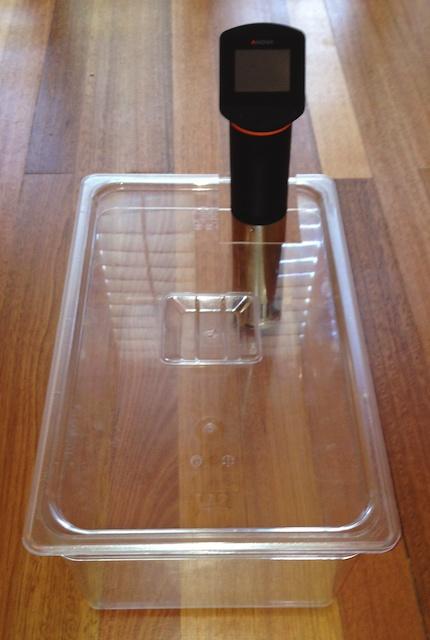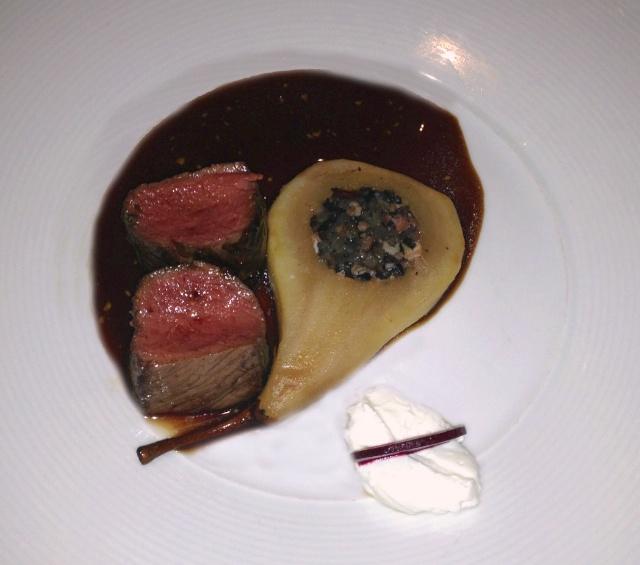-
Posts
2,606 -
Joined
-
Last visited
Content Type
Profiles
Forums
Store
Help Articles
Everything posted by nickrey
-
Easy answer, temperature range for Anova is 25°C to 99°C. Pop it in a colder bath and the heater will not cut in. Voila. Circulator without heater. Although if it's a real ice bath with mainly ice and little water, not sure why you'd want to do this.
-
In Australia the labelling contains two columns, one for a serving size and the other for a standard unit of measurement, in our case 100g. The result of this is that the educated consumer can compare two products directly on the same standard measure to see which is a healthier alternative in terms of sugar, salt, carbohydrates, fat, etc. Our prices are similarly now displayed by standard unit (price per 100g, per kg, etc.) so the smaller, apparently cheaper package, can be directly compared with a larger package containing more of the product. Serving size measurements and measurements for total content per package only go part of the way.
-
While flavour and texture could potentially be artificially separated, taste is really an interaction of the two. I love stocks that are really solid when cold as they have a more unctuous mouth feel when heated. I'd go higher and work backwards.
-

Copper vs Stainless Steel Clad Cookware: Is it worth the $$$?
nickrey replied to a topic in Kitchen Consumer
I'm sure that we've discussed this previously but one factor to keep in mind is the difference between a commercial range and a home cooker. Commercial ranges bathe the bottom of the pan in flame so there is little need for the conductive efficiencies conferred by using copper. At home, however, where the flame contact is more likely to be localised to a small section of the pan the conduction of copper can, and does, make a huge difference in evenness and speed of cooking. I use copper and love it but if I'm using pans other than copper and not on commercial stove, I move to my wok burner ring that has a wider spread of heat. -
Paulraphael talked about food in sous vide being sealed in polyethylene bags. I know that very small molecule such as the flavonoids in cloves go through the plastic but would suggest that the likelihood of BPA in polycarbonate leaching through these bags into the food is very unlikely. I'm definitely open to discussion on this from organic chemists who may think otherwise but, at this stage, I'd suggest that it is drawing a long bow to say that polycarbonate containers are risky, particularly given the paucity of replicated evidence to support an assertion that it really is harmful. gfweb, please don't forget dihydrogen monoxide, which when imbibed in large quantities can kill you.
-
Jo, the Bombay Gins have the dry as well as the Sapphire. I tend to prefer the non-dry sapphire as it tends to have a slightly longer finish. Chris, the Nouaison is more dry than the floral Floraison that we've talked about above. It uses: nutmeg, cubeb berries, ginger roots, liquorice, lime, juniper berries, coriander, cassia bark and green grape flower and from reading reviews probably has more juniper forward than the floraison. It would be good to compare the two to see what the differences are.
-
For smaller and faster cooks I just use a deep pan - the bottom part of my pressure cooker is ideal. For longer and larger cooks I use a 25 liter food safe container that is temperature rated from -40C to +100C. I use the lid with a cutout for the circulator.
-
Good point. Do you have access to a well stocked bar where you could try a couple out rather than buying a bottle of something you mightn't like? Given what you said you like and didn't in spirits your taste preferences seem to be the opposite of mine. I don't particularly like Hendricks gin which is infused with rose and cucumber so that may be a possibility. You could also try chewing on a dried juniper berry; you will know quickly if the taste is for you or not. If it isn't perhaps gin may be a drink you will not like as although we talk about juniper being more or less forward, it is still a central component of the flavour elements in gin.
-
Just bought one. It's my fifth sous vide machine so far. Great for quick cooks and the circulation is strong. I prefer my vac-star sous vide chef II for longer cooks and larger volumes of water but would totally recommend it to someone as a starter unit.
-
Why post in a gin thread if you don't like it? Can't see the sense myself.
-
Firstly, I'd question the ethics of writing a cookbook about things you've never cooked. Secondly, even if we set this aside, the question remains that if you can't gain access to the foods, how is your potential cookbook market going to have access to them? Write about things you know and have experience with. Let me say that again and in bold. Write about things you know and have experience with. Period.
-
Variant on Daniel Humm Venison dish. Served for 47 people. Venison with Pear, Beetroot and Goat’s Cheese. In the middle of the pear was a bacon pannacotta topped with a mushroom, bacon and onion duxelle. The sauce was a reduced veal jus layered with blueberries, juniper berries, and chocolate. Venison was cooked sous vide then seared on a commercial flattop grill and rolled in a reduced veal jus glaze and topped with brown butter and juniper salt.
-
It's called osmazome. Check out this link for a pictorial I did on creating this using mince.
-
Like many others I'm stunned, shocked, and saddened by Steven's sudden passing. If you count lives in terms of impact, his was a full one but in terms of years it was far too short. My deepest condolences to his family and I'm sure that I join everyone here in celebrating his massive contribution to all our lives.
-

Transporting glass bottles in airplane luggage
nickrey replied to a topic in Food Traditions & Culture
Laphroiag send their whisky out in those. I re-use them all the time. -
Sear the prawns on high heat, turn then serve. Why cook sous vide? Sometimes a hammer is too much, choose another implement to hit your nail with.
-
Bone is fine. I'd assume that as it's pork you will be cooking it to between 60 and 62C. In this case it is over 55C the four hour rule is not going to come into play. There only issue with bone is that jagged edges can rip bags You can get special bone guards from butcher supplies but I'd look at them to see that they are made of an appropriate plastic. Because the time to cook is not linear (it increases more exponentially than linearly) cooking a piece of meat that is twice as thick means cooking it for a lot longer than twice the time. Also the bone has different properties to the meat in terms of thermal conductivity so the cooking times may also be altered because of this but I'd just go with the timings as if it were all meat.
-
They're really handy. I use conventional braising, pressure cookers, sous vide., etc. It all depends on what I'm making and what time I have available. You may want to look at a cooking food processor next (Thermomix, Thermochef) as they can make life really easy, especially in making risotto, polenta, cooked oats, etc.
-
The longer cooking time involved cooking the meat sous vide, not as a conventional braise - different process, different times. Don't use your current times for your pressure cooker or you'll wind up with meat particles.
-
I do the same as Chris. Also make sure the liquid is refrigerated before sealing - at room temperature it will boil.
-
You could try G'vine floraison.
-
If you want a really flavoursome stock, you could do what I do and buy a whole chicken. Remove the breasts for other purposes and use the rest of the chicken for stock. I section the chicken into pieces, including cutting the leg and other large bones in half through the bone and then pressure cook the stock. Use of all this meat allows for more water to be used than is normally called for with the weight of the chicken as the extra flavour supports a greater dilution. There is so much flavour in there you can also get a reasonable second run from the remouillage, perhaps boosting the gelatine by adding some of the cheaper cuts referred to above.
-
The fat in this case is hand cut, not minced. The fat needs to be distributed equally throughout the meat. Using finely cubed fat without this process will stick together and not emulsify properly as the salt acts on the chilled mix.
-
It's a generalized sausage making technique to separate out hand cut back fat. A seventh-generation Italian butcher showed it to me in a sausage making class.
-
It works well.




